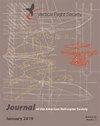鲁棒转子状态估计的观测器
IF 1.4
4区 工程技术
Q2 ENGINEERING, AEROSPACE
引用次数: 0
摘要
本文讨论了综合线性观测器和非线性观测器,仅从机身状态测量来估计旋翼状态。首先,本文回顾了两种用于转子状态估计问题的经典Luenberger线性观测器,并指出了其局限性。在此基础上,提出了一种新的基于滑模理论的鲁棒非线性不连续观测器,可从机身状态测量中同时估计旋翼扑动和前置滞后状态。对于这种新的非线性观测器,本文进行了稳定性分析,以确定在未知但有界的湍流输入下保证转子状态估计精度的条件。非线性观测器也适用于对未知湍流输入的在线和实时估计。在平静和湍流条件下的仿真结果突出了非线性不连续观测器的有效性和性能。这种旋翼状态观测器可以提供一个独立的在线和实时旋翼状态估计来源,以补充或补充各种飞行控制和健康监测功能的原位旋翼状态测量设备。本文章由计算机程序翻译,如有差异,请以英文原文为准。
Observers for Robust Rotor State Estimation
The paper discusses the synthesis of linear and nonlinear observers to estimate rotor states from fuselage state measurements alone. First, the paper reviews two forms of the classical Luenberger linear observer applied to the rotor state estimation problem and identifies some limitations thereof. Thereafter, the paper proposes a new robust nonlinear discontinuous observer based on the sliding mode theory to simultaneously estimate rotor flapping and lead-lagging states from fuselage state measurements. For this new nonlinear observer, the paper presents stability analyses to determine conditions that guarantee rotor state estimation accuracy despite unknown but bounded turbulence input. The nonlinear observer also lends itself to the online and real-time estimation of the unknown turbulence input. Simulation results in calm and turbulent air conditions highlight the efficacy and performance of the nonlinear discontinuous observer. Such rotor state observers could provide an independent source of online and real-time rotor states estimates to complement or supplement in situ rotor state measurement apparatus for various flight control and health-monitoring functions.
求助全文
通过发布文献求助,成功后即可免费获取论文全文。
去求助
来源期刊

Journal of the American Helicopter Society
工程技术-工程:宇航
CiteScore
4.10
自引率
33.30%
发文量
36
审稿时长
>12 weeks
期刊介绍:
The Journal of the American Helicopter Society is a peer-reviewed technical journal published quarterly (January, April, July and October) by AHS — The Vertical Flight Society. It is the world''s only scientific journal dedicated to vertical flight technology and is available in print and online.
The Journal publishes original technical papers dealing with theory and practice of vertical flight. The Journal seeks to foster the exchange of significant new ideas and information about helicopters and V/STOL aircraft. The scope of the Journal covers the full range of research, analysis, design, manufacturing, test, operations, and support. A constantly growing list of specialty areas is included within that scope. These range from the classical specialties like aerodynamic, dynamics and structures to more recent priorities such as acoustics, materials and signature reduction and to operational issues such as design criteria, safety and reliability. (Note: semi- and nontechnical articles of more general interest reporting current events or experiences should be sent to the VFS magazine
 求助内容:
求助内容: 应助结果提醒方式:
应助结果提醒方式:


